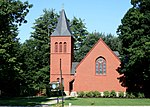Pemigewasset House
1841 establishments in New Hampshire1909 disestablishments in New HampshireBuildings and structures demolished in 1862Buildings and structures demolished in 1909Defunct hotels in New Hampshire ... and 6 more
Demolished buildings and structures in New HampshireHotel buildings completed in 1841Houses in Grafton County, New HampshireNew Hampshire building and structure stubsPlymouth, New HampshireUnited States hotel stubs

Pemigewasset House was a grand hotel in Plymouth, New Hampshire. It began as a tavern in 1800. In 1841 Denison Burnam turned it into Pemigewasset House, and it tripled in size by 1859 with a grand dining room and railroad depot among the additions. A fire destroyed it in 1862, and a new four-story hotel was constructed on the site. It was served by the Boston, Concord, & Maine Railroad with its own depot. Guests included President Franklin Pierce, a regular, and Nathaniel Hawthorne who died at the hotel. It, too, was destroyed by fire in 1909.
Excerpt from the Wikipedia article Pemigewasset House (License: CC BY-SA 3.0, Authors, Images).Pemigewasset House
Highland Street,
Geographical coordinates (GPS) Address Nearby Places Show on map
Geographical coordinates (GPS)
| Latitude | Longitude |
|---|---|
| N 43.7568 ° | E -71.6881 ° |
Address
Northway Bank
Highland Street
03264
New Hampshire, United States
Open on Google Maps








